FOOD AND DRINK

The vaulted cellar bar lays claim to monastic roots with a Whitefriars Carmelite priory that once stretched from Fleet Street to the Thames.
Ye Olde Cheshire Cheese

The old Chop Room restaurant on the ground floor. Low levels of lighting are said to be mandatory throughout the pub.
Ye Olde Cheshire Cheese, one of London’s most atmospheric pubs, requires two signs to attract and direct its customers. The first hangs outside 145 Fleet Street, the pub’s address, but where no door exists. The second sign lies over the pub’s entrance to the side, in a narrow alley called Wine Office Court. There is little hint here of the warren of bars, eating places and function rooms that are to be found inside the rambling pub.
The Cheese, as it is known by regulars, is a charming and bewildering place, because there are perhaps ten rooms on different upper levels, all connected by several narrow staircases, and two levels of cellars. Natural lighting is restricted, but its paneled wood and brick interiors give drinkers and eaters a feeling of welcome and intimacy.
A thirteenth-century Carmelite Monastery guesthouse originally occupied the site. The vaulted cellars are from the 1530s, but elsewhere the building dates from 1667 and the major rebuilding that was required as a result of the destruction wrought by the Great Fire of London. Layers of history have obscured the origins of its antique name. There was a Horn Tavern on Fleet Street recorded in 1538, and this may have been rebuilt and renamed after the Great Fire. A sign by the entrance dates its history to that rebuilding during the reign of Charles II, and it has continued trading during the reigns of fifteen sovereigns from James II onwards.
Its patrons have included many among the historical literary elite. It is particularly associated with Dr Samuel Johnson, who resided close to The Cheese in Gough Square. He is most famous for his Dictionary – published in 1755 – and the author, editor, biographer, critic, essayist and raconteur would have known the establishment well, although opinions differ as to the extent he was a genuine Cheese regular.

This lamp marks the main entrance on the side of the pub; the origin of The Cheshire Cheese’s name remains a mystery.
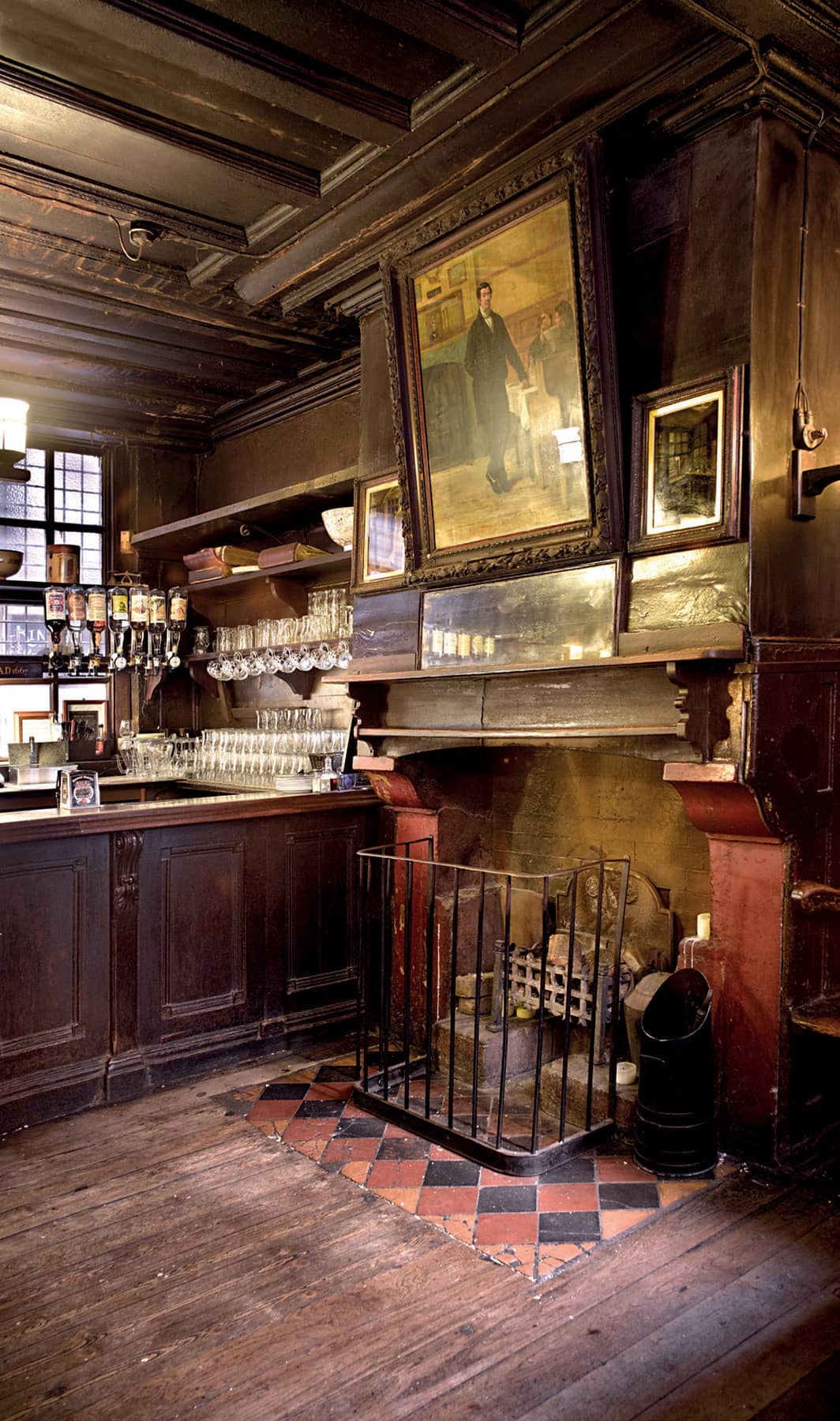
In the ground-floor bar, there is sawdust on the floor and a fireplace under pictures related to history of The Cheese.
Another sign declares that visitors included Oliver Goldsmith (a good friend of Johnson’s best known as the author of The Vicar of Wakefield), P.G. Wodehouse, Wilkie Collins, Arthur Conan Doyle and even a visiting Mark Twain. All preferred the warmth of an alehouse to the more stuffy surroundings of gentlemen’s clubs in the smarter areas of London, while the location of the tavern conjures up literary images of the maze of dark streets and alleyways inhabited by characters portrayed in Dickens’ works.
Dickens knew The Cheese. This is believed to be where Sydney Carton takes Charles Darnay in A Tale of Two Cities ‘down Ludgate Hill to Fleet Street and up a covered way into a tavern’ to restore his strength ‘with a good plain dinner and good wine’. The Irish poet W.B. Yeats and the Rhymers’ Club met here in the 1890s, seated downstairs in high double-seated pews with a table between. He wrote: ‘After supper at which we drank old ale and other time-honored liquors, we adjourned to a smoking-room at the top of the house, which we came to look upon as our sanctum. There long clays or churchwarden pipes were smoked.’
The Cheese makes the most of its literary links, even if some of the legends are hard to pin down or verify, but there is no doubting its journalistic connections.
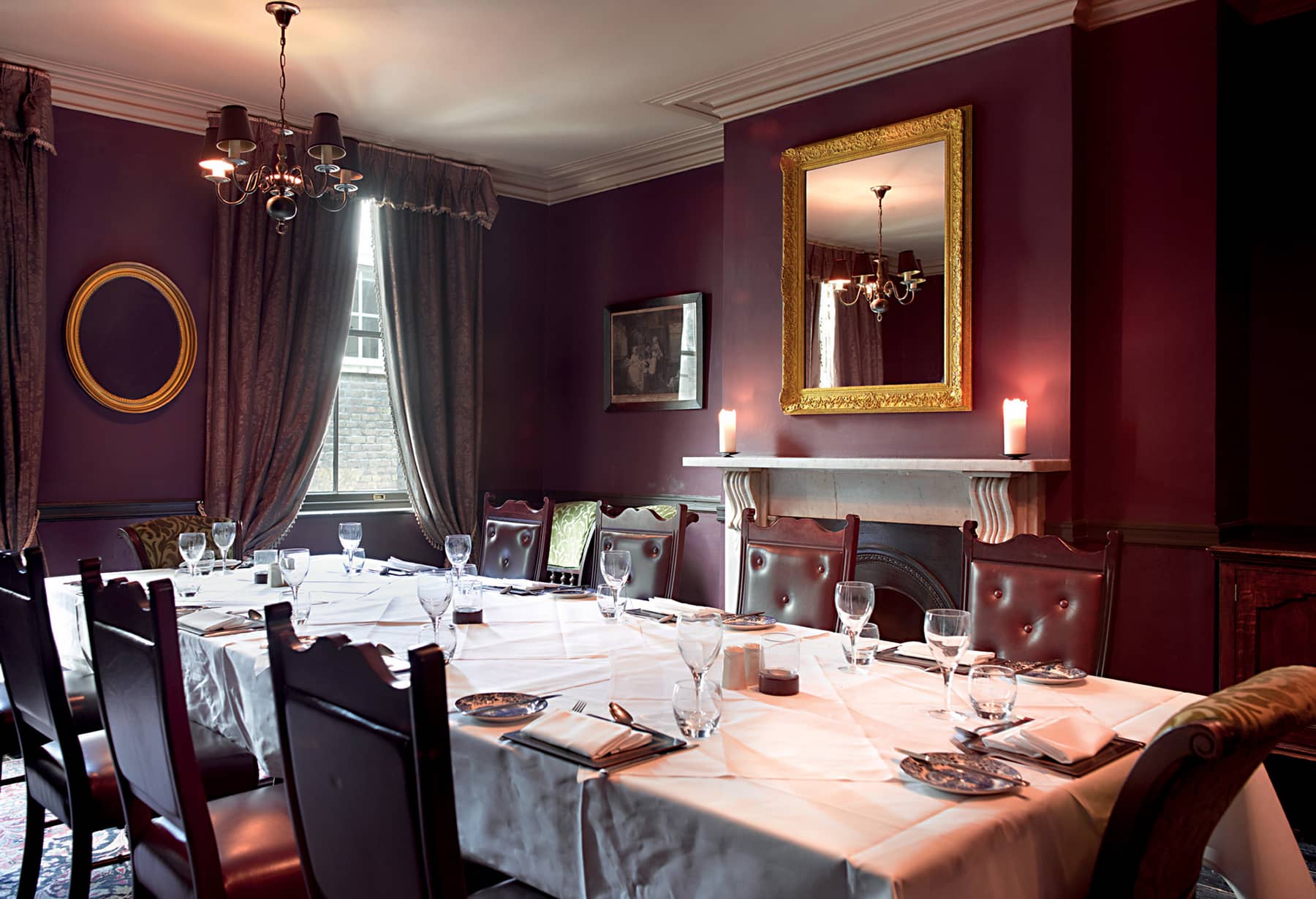
The Directors’ Dining Room for functions on the fourth floor.
Fleet Street – named after the River Fleet that still flows close by, but long hidden underground – was for centuries associated with printing, and the area became home in the twentieth century to many of Britain’s national newspapers, as well as wire services and agencies. During those years, The Cheese became almost notorious as a sawdust-carpeted watering hole for journalists and newspaper print workers, especially for those with guests or those who wanted to avoid some of the more open dens of Fleet Street. It was a place for reporters to argue the merits of a potentially exclusive story, to entertain contacts or simply to drink. New print technology caused a migration from Fleet Street before the end of the 1980s.
The Cheese is also known for a non-human regular. An African grey parrot called Polly that was associated with the pub for many years until its death in 1926 is preserved on display above one of the bars.
Now forming part of the Sam Smith brewery chain, Ye Olde Cheshire Cheese has no website, in keeping with its old-fashioned charm, and real fires continue to add to the ambience that makes it a warming location for those in search of London’s hidden depths.
VISITING INFORMATION
Ye Olde Cheshire Cheese, 145 Fleet Street, EC4A 2BU
Open 11am–11pm Monday–Saturday, 12pm–4pm Sunday.
Bibendum

Stained glass closely based on one the first Michelin posters of 1898, the tyre-man who absorbs and drinks up obstacles on the road.
A unique industrial building, bearing one of the most recognisable figures in corporate advertising, became a smart new Chelsea restaurant in 1987. Bibendum is the name of the Conran restaurant at 81 Fulham Road, and also the true name of the Michelin Man mascot, who decorates the extraordinary building known as Michelin House.
French tyre manufacturer Michelin started work on a London headquarters incorporating a tyre depot in 1910. The building was one of the first in central London to use the Hennebique reinforced-concrete method used for warehouses, as local authorities started to allow wider use of this new type of construction. This would have enabled smooth unembellished concrete walls from top to bottom, but Michelin House emerged as an extravagantly styled palace, glazed with terracotta, and with monogrammed decorative ironwork. Two glass cupolas sit on turrets in the form of stacked tyres. The Michelin identity is everywhere: in script, corporate colours and signage, in the shapes of wheels and tyres, representations of rubber plants, and in the form of Bibendum himself on stained-glass windows and mosaic floors. Pictorial tiles, by Gilardoni Fils et Cie, depict motor sporting scenes from the Edwardian age, celebrating Michelin’s early motor sporting successes.
Overall, the building represented an audacious corporate statement, a pioneer of branding and public relations. No architect is associated with the building, which was handled in-house by a Michelin engineer named François Espinasse and by the British-based agency for the Hennebique system. No particular architectural style is followed; Michelin House did not quite conform to the style of the Art Noveau period. Opening in 1911, it even seems to anticipate elements of Art Deco style by ten or fifteen years. It does owe something to the imagination of Edouard and André Michelin, the brothers who, while building an empire based on bicycle tyres, developed a shrewd notion of corporate identity and publicity. An inspired action was their development of a cartoonist’s image into the company trademark symbol Bibendum, the tyre-man who drinks up obstacles on the road with the motto ‘Nunc est Bibendum’, meaning ‘now is the time to drink’.
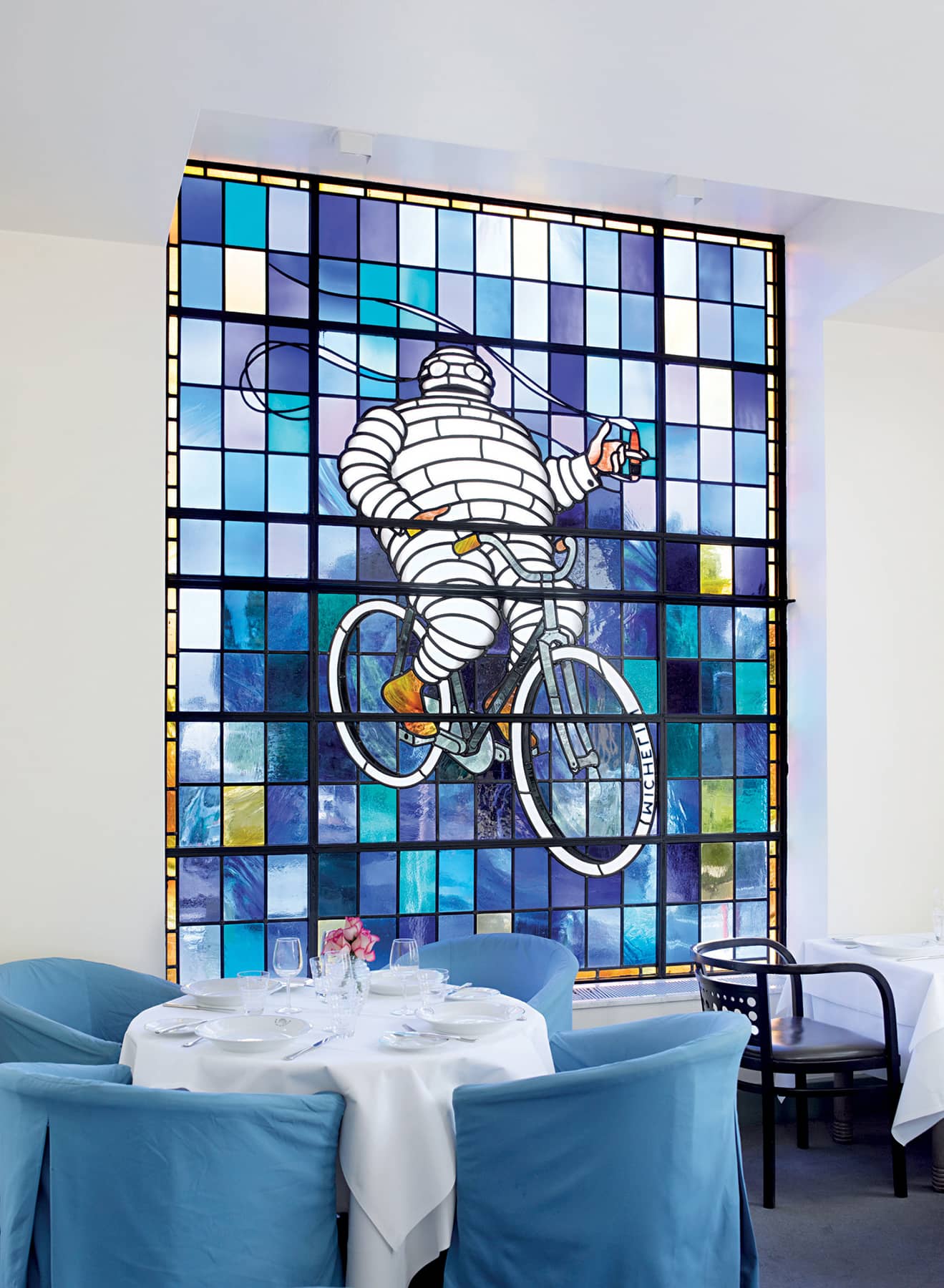
Based on an early advertising poster, Bibendum smokes and rides, and reminds us that Michelin’s first success was bicycle tyres.
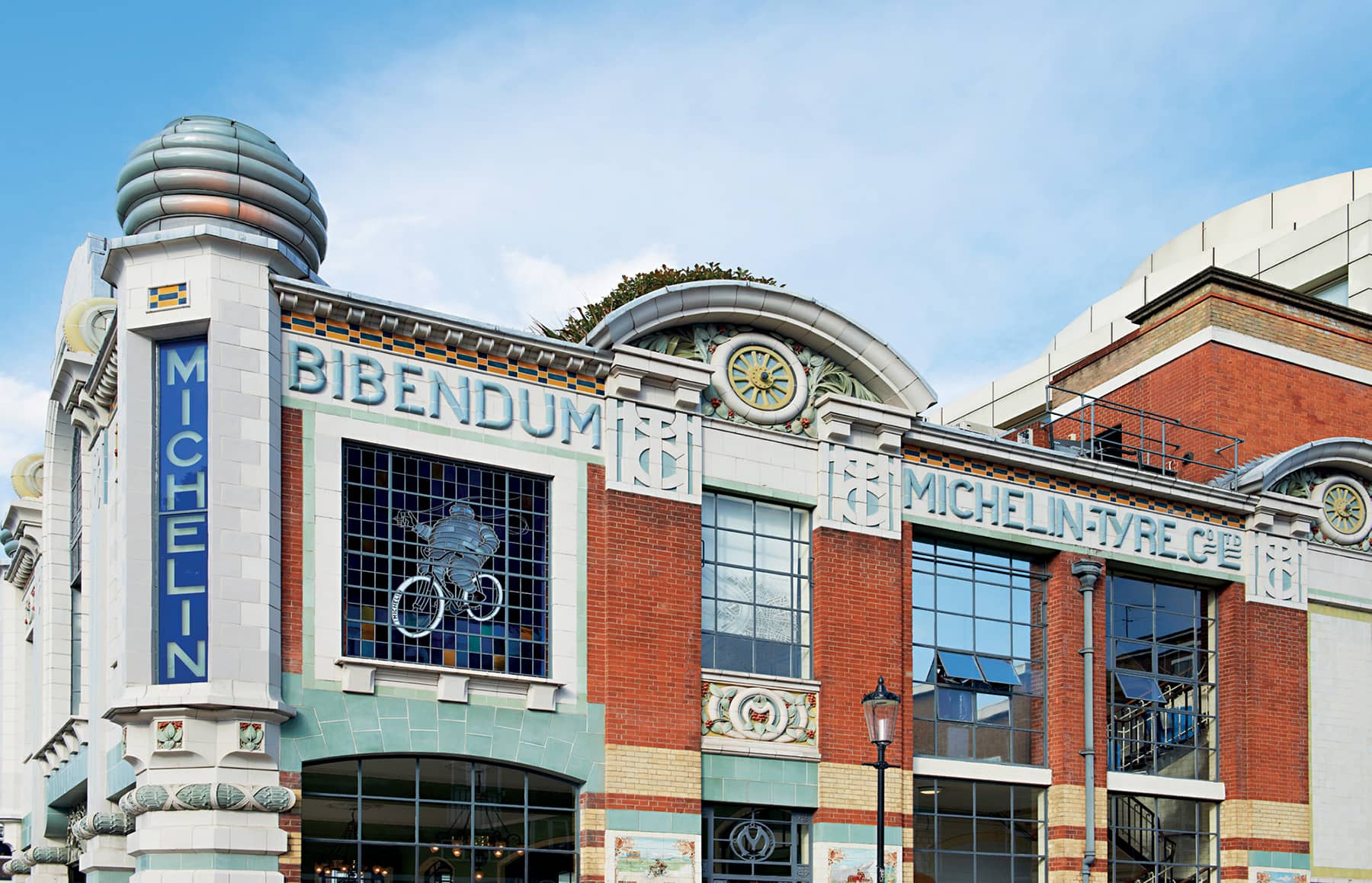
Michelin House, corporate headquarters and early tyre-fitting centre, has an architectural style which defies definition, being completed at the end of the Art Noveau period and pre-dating the emergence of Art Deco.
When the Michelin company finally departed and sold the Fulham Road building in 1985, it was purchased by Sir Terence Conran, restaurateur, designer and retailer, and Paul Hamlyn, publisher. Extensive architectural work followed, adding a new floor and a steel-and-glass addition on the west side. A Conran shop, extensive office space, and oyster bar, café and restaurant on the first and ground floors were opened.
The new Bibendum restaurant, with Simon Hopkinson as chef and joint proprietor, continued the Michelin synergy that linked travel to eating places, guidebooks and maps. It re-introduced three stained-glass windows into what had become a luxurious dining room. This required extensive research of old photographic material to replicate the original windows as precisely as possible.
The three original windows in the first floor offices at Michelin House had been taken down in 1939 and placed in packing cases before removal to the company’s factory at Stoke-on-Trent for safe keeping during the war. When the company completed an audit in 1948, the windows could not be found. There were rumours that the stained glass had been spotted at various times during the 1960s and 1980s. In 2010, as the 100th anniversary of Michelin House approached, the tyre-maker declared an amnesty in a bid to find the missing windows. A confidential hotline and a webpage were advertised by Michelin and hundreds of reports came in, some suggesting the windows were still in Staffordshire, or could be found in Australia or Canada. But none of the leads generated by the appeal led to the missing windows.
L. Manze

The dining room has tin ceiling panels, the seating is fixed, the floor is terrazzo and all is original.
The L. Manze establishment on Walthamstow High Street is a classic example of an unmistakeable London building type: the eel, pie and mash shop. This was recognised by English Heritage when it was awarded Grade II listing in October 2013.
One of the reasons given for the listing is the shop’s interior, which is particularly stylish and exceptionally complete and original. The walls are lined with green-and-white tiles, with a frieze of wreaths joined by ribbons running around the top. Bevelled-edge mirrors are inset. Marble-topped tables are fixed to the pink-and-grey terrazzo floor in a series of seating booths, with benches within high-backed timber partitions. The cream-coloured ceiling appears to be tiled, but is made of pressed-tin panels. Manze is a shop-restaurant, and the serving area has marble counters and shelves, old-fashioned zinc-and-hardwood work surfaces and an antique cash register. On a small counter there is a place where fresh eels were once displayed on ice.
Outside, a black Vitrolite glass fascia bears the shop name in gold drop-shadow capitals. It is clear that the sash windows once worked as serving hatches for takeaway sales. The shop was opened in 1929, and a strong modern image was carried throughout, while incorporating traditional Victorian elements. A pie and mash shop has to look like this. The architect was Herbert Wright, who was responsible for several other commercial properties in north London on the Clerkenwell and Pentonville Roads, but none as memorable as L. Manze.
Eel, pie and mash shops started in London during the 1860s, developing from the street sellers who sold pies and eels: cheap food. Eels may have been an original pie filling. The social historian Henry Mayhew described how hundreds of street sellers were soon supplanted by pie and mash shops. By 1874 there were thirty-three listed in the London trade directories, and in February 2016 there were still around twenty-five traditional pie and mash shops with London postcodes, according to the Pie & Mash Club, with fifty-two more further outlying. There was a strong history of particular families being associated with the business: the Cookes, Manzes, Burroughs, Kellys and Goddards, and some of those names can still be found on pie and mash shopfronts today.
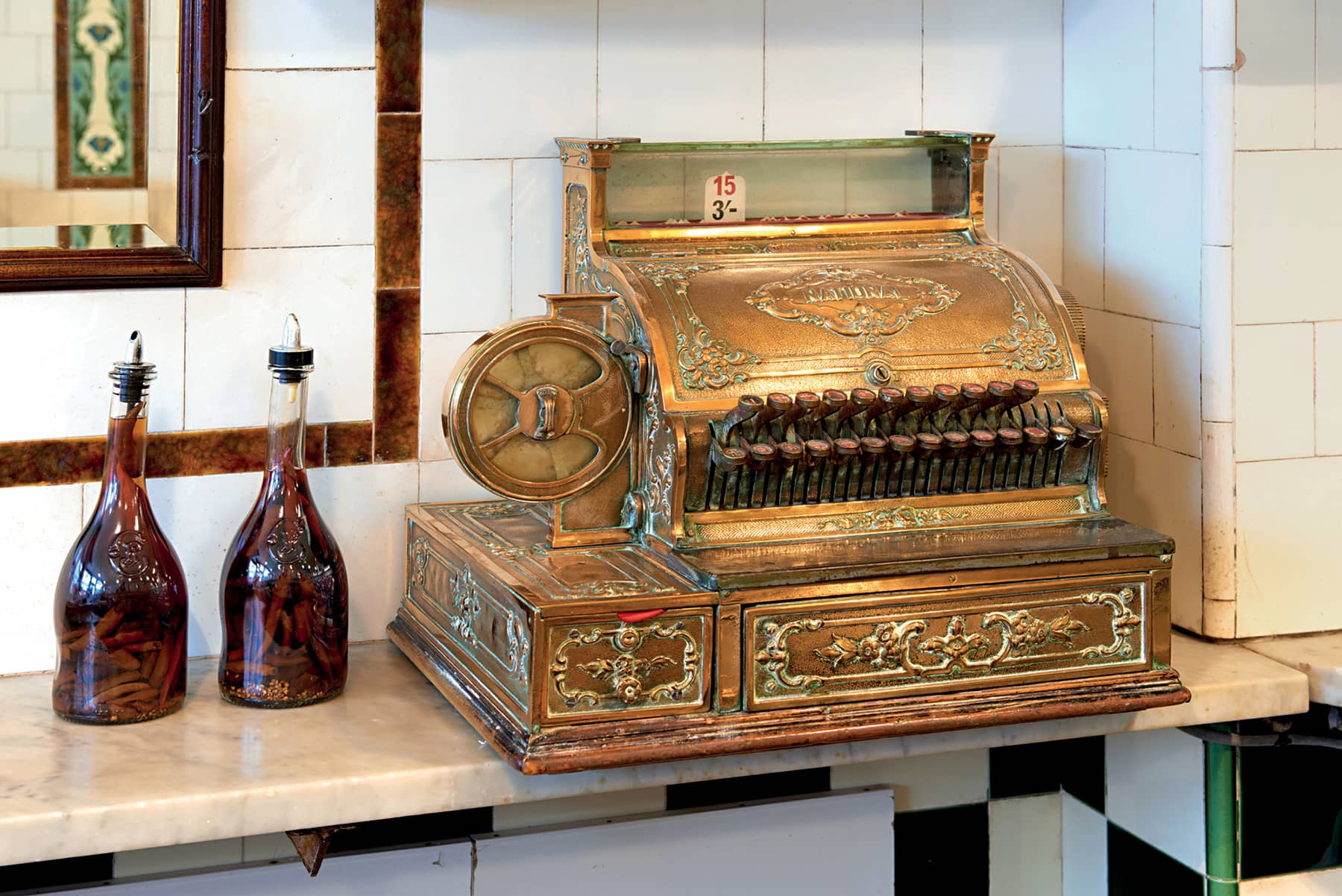
The antique cash register is now an ornament, but it seems to have been operational in decimal currency times.
The Manze family came to England from Italy in 1878. Michele Manze married a daughter of pie shop operator Robert Cooke, and opened a number of shops, and in turn his son Luigi opened the L. Manze Walthamstow shop, which was run by the family until 1970. Current owner Jacqueline Cooper and family have run the shop since 1986. Shops of the M. Manze empire continue, and the original one of these at 87 Tower Bridge Road in Bermondsey won listed status in 1998.
There is clearly growing respect for the architecture and cultural significance of eel, pie and mash shops, and, in the age of funky food, possibly a greater enthusiasm for the menu: the pies, which are made every day on the premises, and for the mash and mysterious liquor.
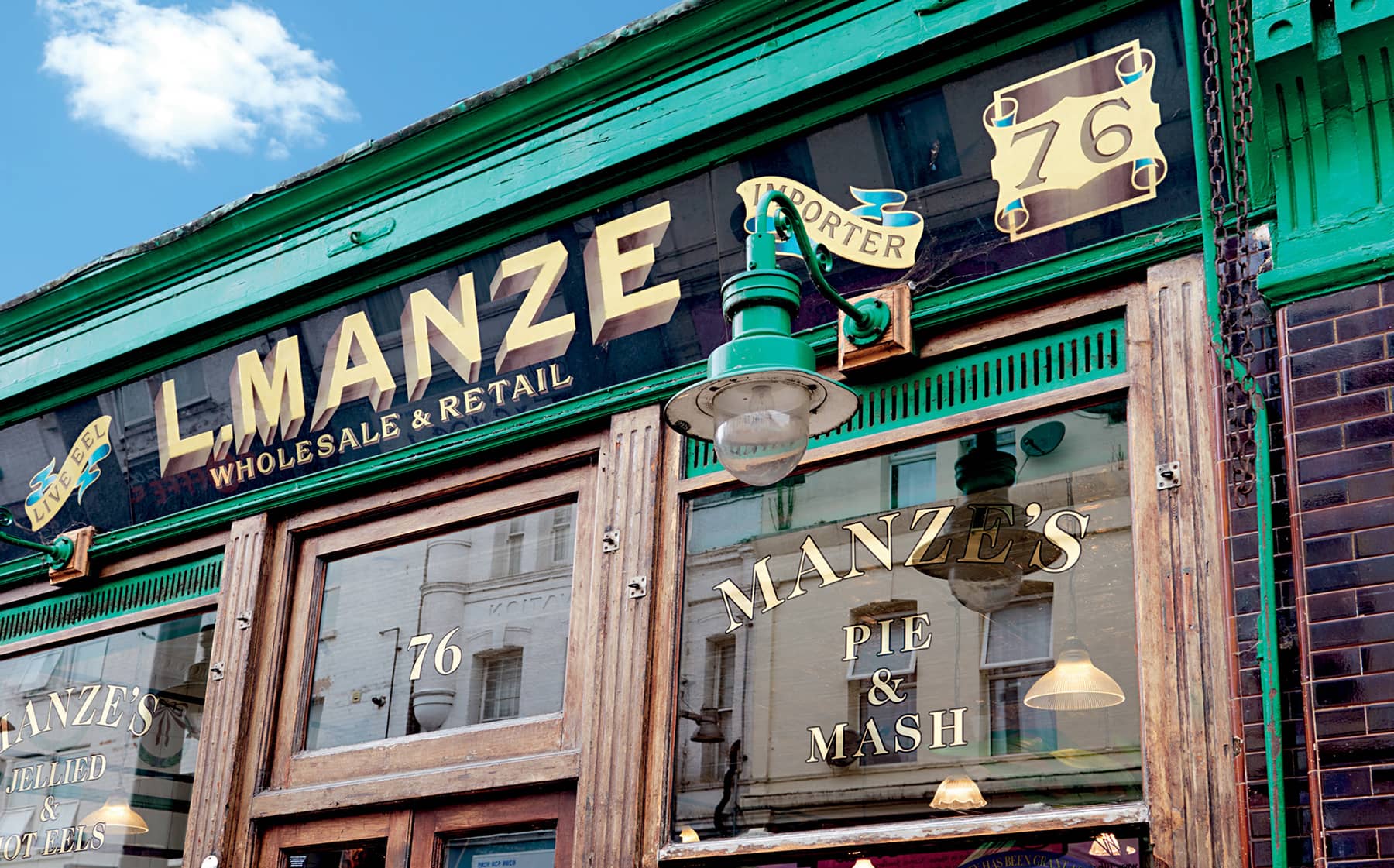
On opening in 1929, the black glass fascia was up-to-the-minute.
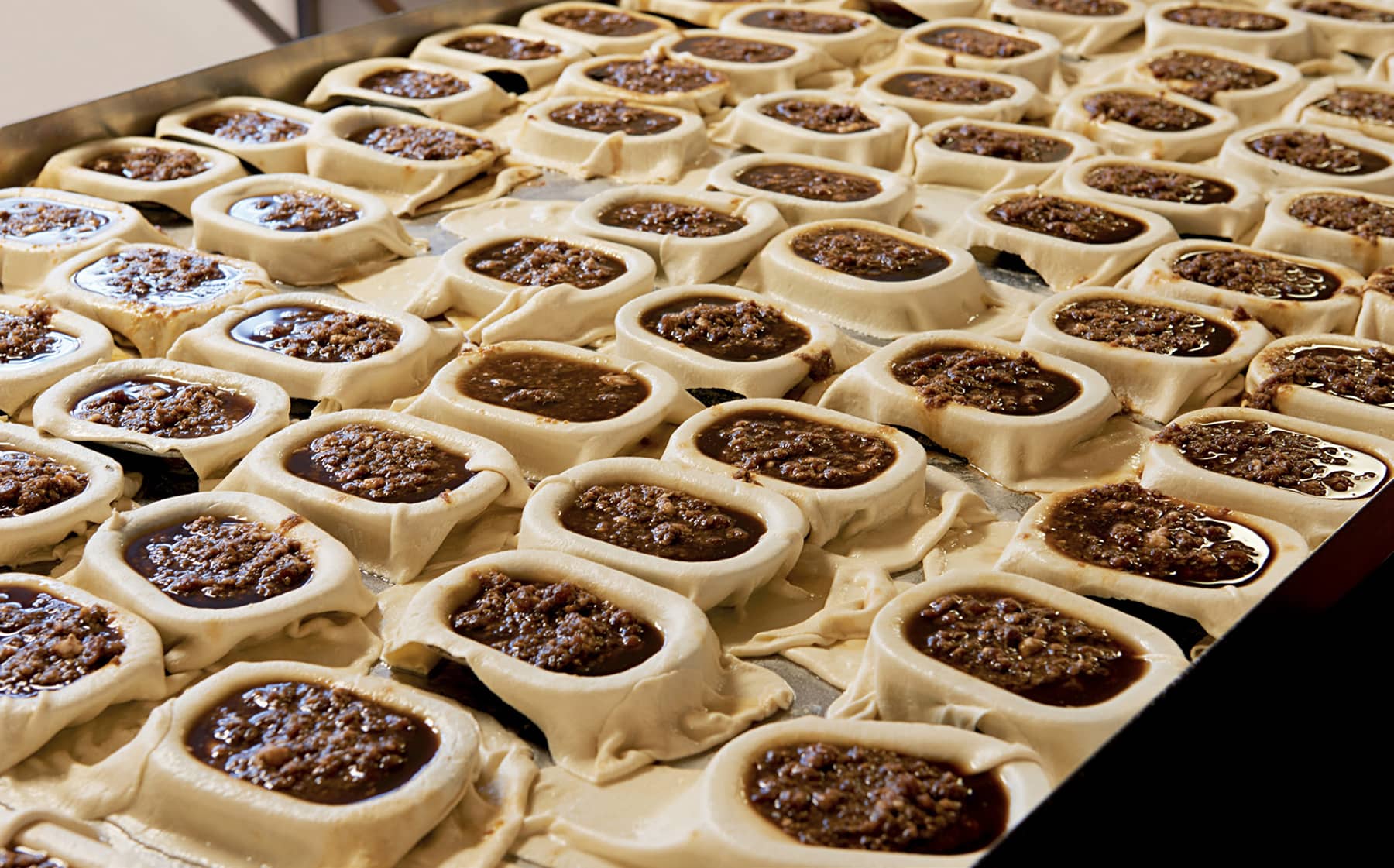
Pies are cooked fresh every day on the premises.
VISITING INFORMATION
L. Manze, 76 Walthamstow High Street, E17 7LD
Open 10am–5pm Monday–Saturday.
Smithfield Meat Market

The Grand Avenue screen and gates restored to original colour scheme of 1868. The traders are located beyond the gates. A four-faced drum clock by Thwaites & Reed of Clerkenwell was installed in 1870 and hand-wound for almost a century before conversion to electricity.
Smithfield Meat Market is the great survivor of the wholesale markets of central London. It is owned by the City of London and operates in its original 1868 buildings inside the northern edge of the Square Mile. Properly known as London Central Markets, it handles over 100,000 tonnes of meat each year. Its architect was Horace Jones, who designed Tower Bridge. One of the surprises of Smithfield is how much of the original has survived. The goods yard is now a car park, but is served by the same spiral ramp, with the rotunda garden inside. The hydraulic lifts that raised the meat to market have gone, but Metropolitan tracks remain below as the busy Thameslink and Crossrail lines. The poultry market building alongside dates from 1875. Following a fire in 1958 this was rebuilt in 1963 with a clear span-domed roof.
The major changes to the market have been to working practices. Besides butchers and cutters, some trades dated back 130 years: the ‘drawers back’, the ‘pitchers’, ‘humpers’ and ‘bummarees’. Most of that has gone, and in the 1990s the inside of the east and west wings was transformed. What once were open arcades with individual stalls were converted into more than forty temperature-controlled areas for tenants, together with sealed loading bays and an overhead hookline meat-handling system.
VISITING INFORMATION
London Central Markets, EC1A 9PS
http://www.smithfieldmarket.com
The Market officially closes at midday, but it is best seen during its working hours between 3am–7am. Walking tours take place once a month. Book in advance.
The Ivy

The island bar was introduced to The Ivy as part of its most recent refit in 2014–15.
Look at a map showing the two square miles known as Theatreland, put in a pin in the central point, and there you will find the Ivy restaurant. It is has existed for more than a hundred years on a sharp corner of West Street and Litchfield Street, near Covent Garden. The Ivy is rated as one of the most stylish dining spaces in London, and is inseparable from the world of show business, theatre, celebrity and the arts.
As its reputation has grown, it has gone through many changes of ownership and several redesigns. The latest was a major reworking in 2014–15 by Brudnizki Design Studio, which updated throughout the traditional Ivy theme of green-and-red leather and mohair-trimmed seating. It introduced an island bar, employing advanced lighting techniques and mirrors, into the wood-panelled dining room, with a mixture of tables and banquettes.
From the outside, the diamond-patterned stained-glass windows are the signature feature, the randomly placed coloured panes offering illumination and a discrete environment for the diners inside. It’s hard to see inside from the street.
Another Ivy tradition, one that dates from a refurbishment in 1990 by M.J. Long, is its inclusion of modern art, and this has been maintained and updated. Some of the pieces were specifically tailored to the room and some make witty connections with the world around the Ivy. Terry Farrell, the sculptor who created famous dancing hares, contributed Stage Door Johnny, a top-hatted theatre-going bronze hare. Other artworks are by Damien Hirst, Peter Blake, Tracey Emin, Patrick Caulfield and Eduardo Paolozzi.
The Ivy opened in 1917, initially as an unlicensed one-room café in what was then a narrow house in West Street. Ivy legend says that the restaurant’s name was chosen after the original proprietor, Abel Giandellini, apologised for noisy building work in progress. He was told by customer Alice Delysia, a notable revue actress of the day, not to worry. ‘We’ll cling together like the ivy on the old garden wall,’ she said told him, paraphrasing a line from a popular song of the time.

Tom Phillips’ The Professionals: ten panels in the style of old-fashioned cigarette cards, depicting modernist artists in various fields. Each of them, while devoted to creativity, also had surprising professions.
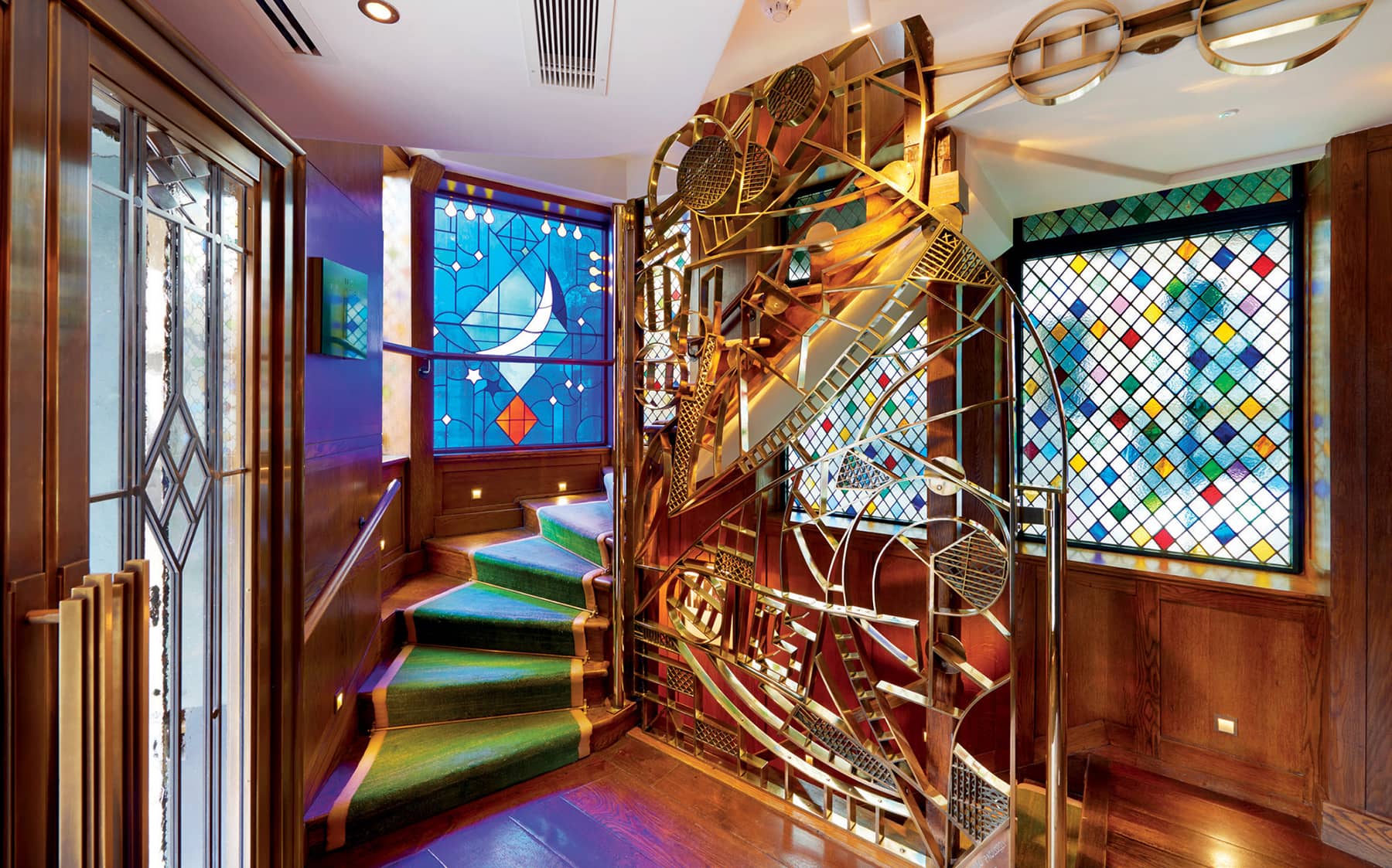
By the entrance, a stained glass window Paper Moon by Patrick Caulfield includes theatrical dressing room light bulbs. In the foreground is an untitled brass strap screen of mechanistic shapes by Eduardo Paolozzi.
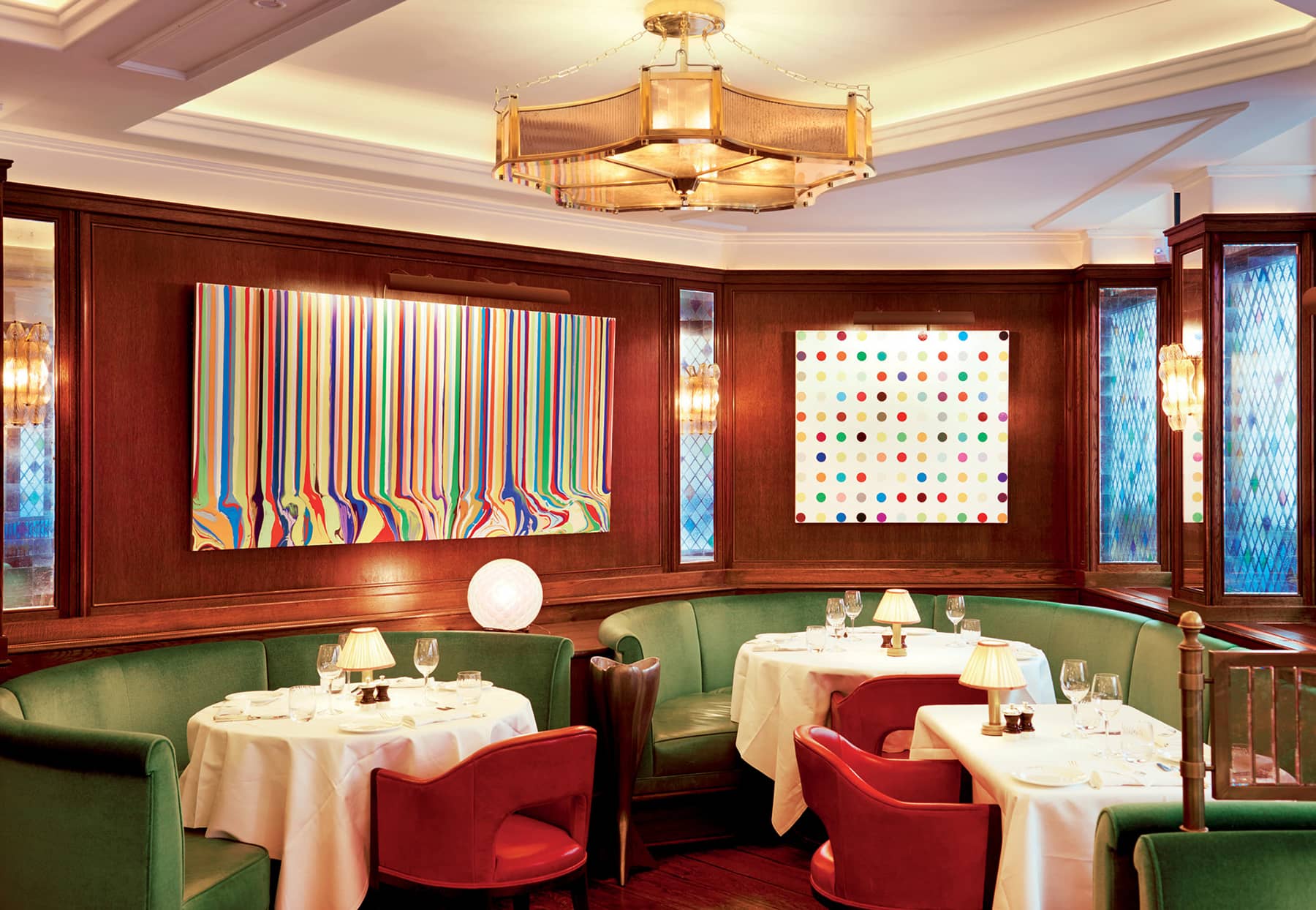
Paintings by Ian Davenport and Damien Hirst.
The Ivy’s menus are not based on any one style or regional cuisine, but are described by the restaurant itself as ‘modern dishes with international influences, with a particular nod to Southern Europe and Asia’. There are modest dishes such as liver and onions, and the Ivy burger and shepherd’s pie are famed, maintaining a connection with the days when the café sold cheap meals to actors. A leading theatre critic has claimed that the Ivy is affectionately known as ‘the works canteen’ by certain actors, but the critic or the actors may have been ironic. Writer and restaurant critic A.A. Gill said ‘a table at the Ivy is one of the most sought after pieces of furniture in London’.
The original one-room lino-floored café was extended in 1920, and in 1928 the establishment was properly rebuilt to fill out into the space occupied by the Ivy today. The restaurant now seats more than 100 people, and there is a private dining room upstairs. During the 1930s its reputation grew under manager Mario Gallati, who went on to open Le Caprice in 1947. The Ivy clientèle soon expanded to include politicians, writers and those from what is today described as the media. The Giandellini–Gallati era ended with the sale of the Ivy to the Wheeler’s group of restaurants, then to the Forte Foundation. Briefly closed, the Ivy was revived by Jeremy King and Chris Corbin in 1990 and is now owned by Caprice Holdings.
The Blackfriar

The striking signage in green-and-gold mosaic dates from the 1903 remodelling.
The Blackfriar pub on Queen Victoria Street stands like half-opened book, with the stone figure of a friar embedded on its spine. Inside lies an Arts and Crafts-styled fantasy world unlike any pub in London.
The multi-coloured marble-faced walls are adorned with pictorial panels and friezes. The decorative theme is based on monks and good spirits, with happy friars living jolly lives. Monks are depicted fishing, gardening, washing and pushing a wheelbarrow carrying a trussed pig. Everywhere there are mosaics, copper reliefs, scripts bearing axioms, stained glass, brass, mahogany and mirrors. A light-hearted design touch is applied with high-quality materials used throughout. Outside, the style continues: the clock on the spine has a mosaic face and even the strictly commercial signage for ‘Worthington Ales in a Bottle’ and ‘Booths Gin’ is rendered in copper relief with Arts and Crafts fonts, flanked by figures of friars. All of this was inspired by the Dominican monastery that existed close to site between 1221 and 1538, and gave its name to the Blackfriars area.
A late addition to the pub, beyond the original bars, was the Grotto, a barrel-ceilinged room lined with alabaster and marble, built out into a vault under the neighbouring railway, separated from the saloon by three arches. There are no windows, but mirrors are used to good effect. Despite the apparent constraints of its shape, The Blackfriar is deceptively roomy.
The pub was built in 1875, but did not gain its special interior until it was remodelled in 1903. Herbert Fuller-Clark was the architect, and sculptors Henry Poole, Frederick Callcott and carver Nathaniel Hitch were employed to create the decorative features. The curious shape of The Blackfriar can be understood by its position next to the old London, Chatham and Dover Railway line running alongside, which existed before the pub was built. The back wall of the pub was built right against both the railway and a signal box that straddled several tracks at this point. Back then, the railway bridge over Queen Victoria Street was tight against the pub because it was more than twice as wide as the bridge in place today. It was the reduction of tracks and the narrowing of the bridge that cast The Blackfriar adrift. The pointed end of The Blackfriar was generated by the need to fit into the irregular ground plan of streets existing at the time.

‘Merrie England’ scenes of frolicking friars are displayed in copper relief.
The Blackfriar was under threat in 1964, when the area around it was slated for redevelopment and the pub marked down for demolition. The preservation movement was at that time gathering support, after early setbacks in London, and a campaign by the Victorian Society, led by poet Sir John Betjeman and Lady Dartmouth, saved it.
In a pub bristling with interesting features, there is a plaque outside making a possibly tenuous claim: ‘It is believed that Emperor Charles V, the Papal Magistrate and Henry VIII’s court sat on this very site during the dissolution of Henry VIII’s marriage to Catherine of Aragon in 1532.’ Elsewhere, it has been recorded that during the proceedings King Henry detested the stink of the Fleet River, which flowed into the Thames at this place.
London’s lost Fleet River certainly now flows underground a few feet from The Blackfriar, and nearby it is possible to find fragments of stonework from the lost abbey of Blackfriars, and the theatres and courtyards that supplanted it in Shakespeare’s time. There is a true whiff of history at this spot and a maze of streets to explore just a few steps away.
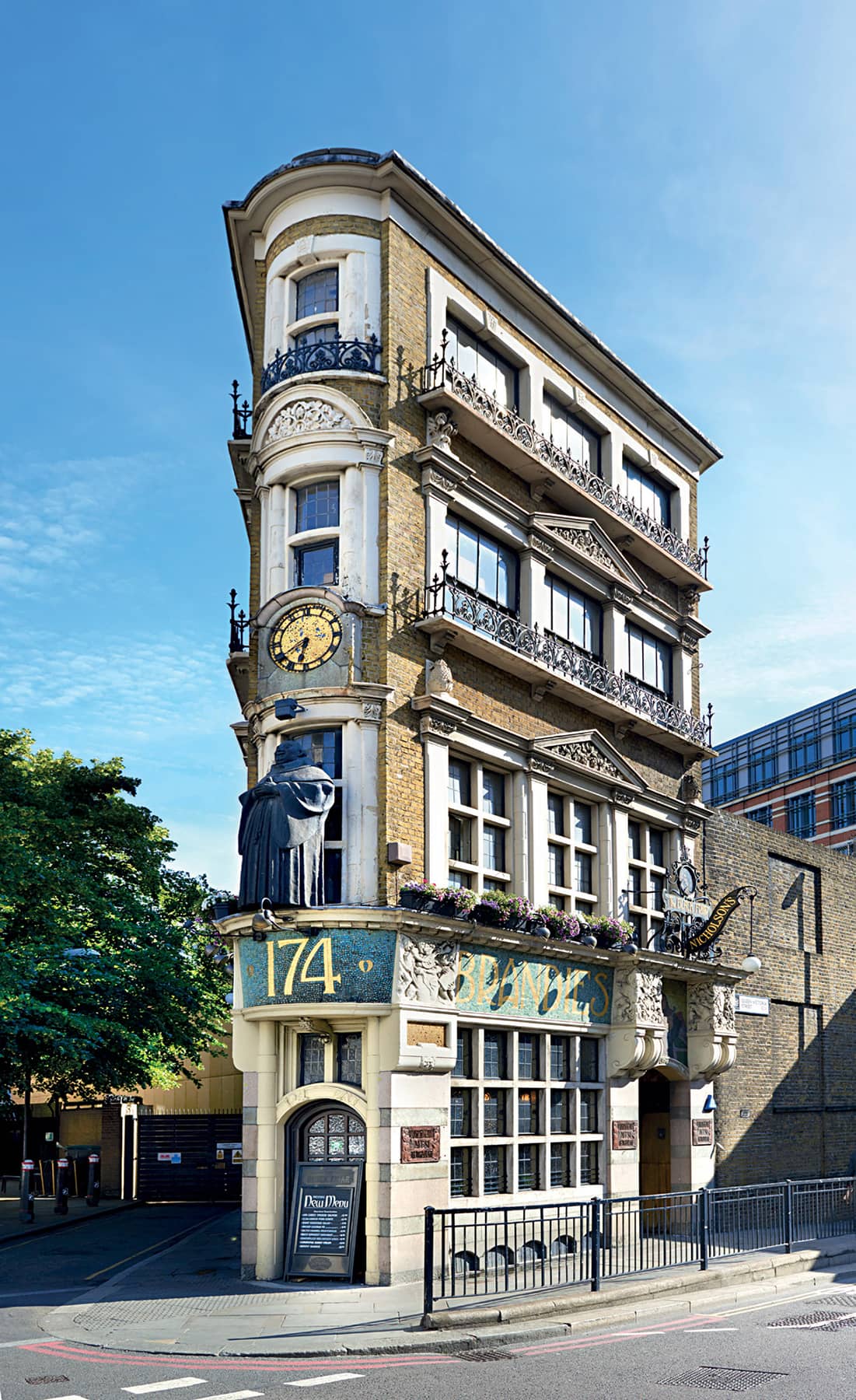
Standing alone, The Blackfriar fitted tightly into its previous surroundings.
VISITING INFORMATION
The Blackfriar, 174 Queen Victoria Street, EC4V 4EG
http://www.nicholsonspubs.co.uk
Open 9am–11pm Monday–Saturday, 12pm–10.30pm Sundays.
Berry Bros & Rudd

One of a vast network of wine cellars belonging to Berry Bros & Rudd.
At street level it is hard to guess the full extent of Berry Bros & Rudd, Wine & Spirit Merchants, but there are clear signs of its antiquity. The windows of No. 3 St James’s Street proclaim that it was established in the seventeenth century, and the paintwork on the frontage appears ancient, apparently black but in reality the darkest possible shade of green. Wine cellars below the shop extend for 2 acres to the back, front and side of the building.
A hanging sign outside shows a coffee mill, which was one of the shop’s first lines of business, along with tea, snuff, sugar and spices, mostly imported from the New World. It was opened as a grocer’s store in 1698 by a widow named Bourne, possibly Katherine Bourne, and served the increasingly fashionable area of St James’s with its coffee and chocolate houses. Her descendants, including one George Berry, shifted the business emphasis to wine by the early nineteenth century.
Inside the panelled shop with its sloping wooden floor, hangs a large set of scales once used to weigh goods and, curiously, some of the customers. It used to be fashionable for men to have themselves weighed while they made their purchases, a set of scales being scarce domestic devices and knowledge of weight showing an awareness of health. At Berry Bros, the ledger has recorded since 1756 the results of some illustrious subjects, including the Regency dandy Beau Brummell, who was weighed here several times, Lord Byron, Lord Melbourne and Sir Robert Peel.
In the time of Beau Brummell, wine was not regarded as a luxury item, for however expensive it was the bottle was always worth more. Wine was bought by the cask, and the servant whose job it was to put the cask wine into bottles was called the ‘bottler’, from which the word ‘butler’ derives. Bottling only became economical in the early twentieth century; any vessels dating from older times are now rare and expensive. Berry Bros & Rudd displays an antique collection of these.
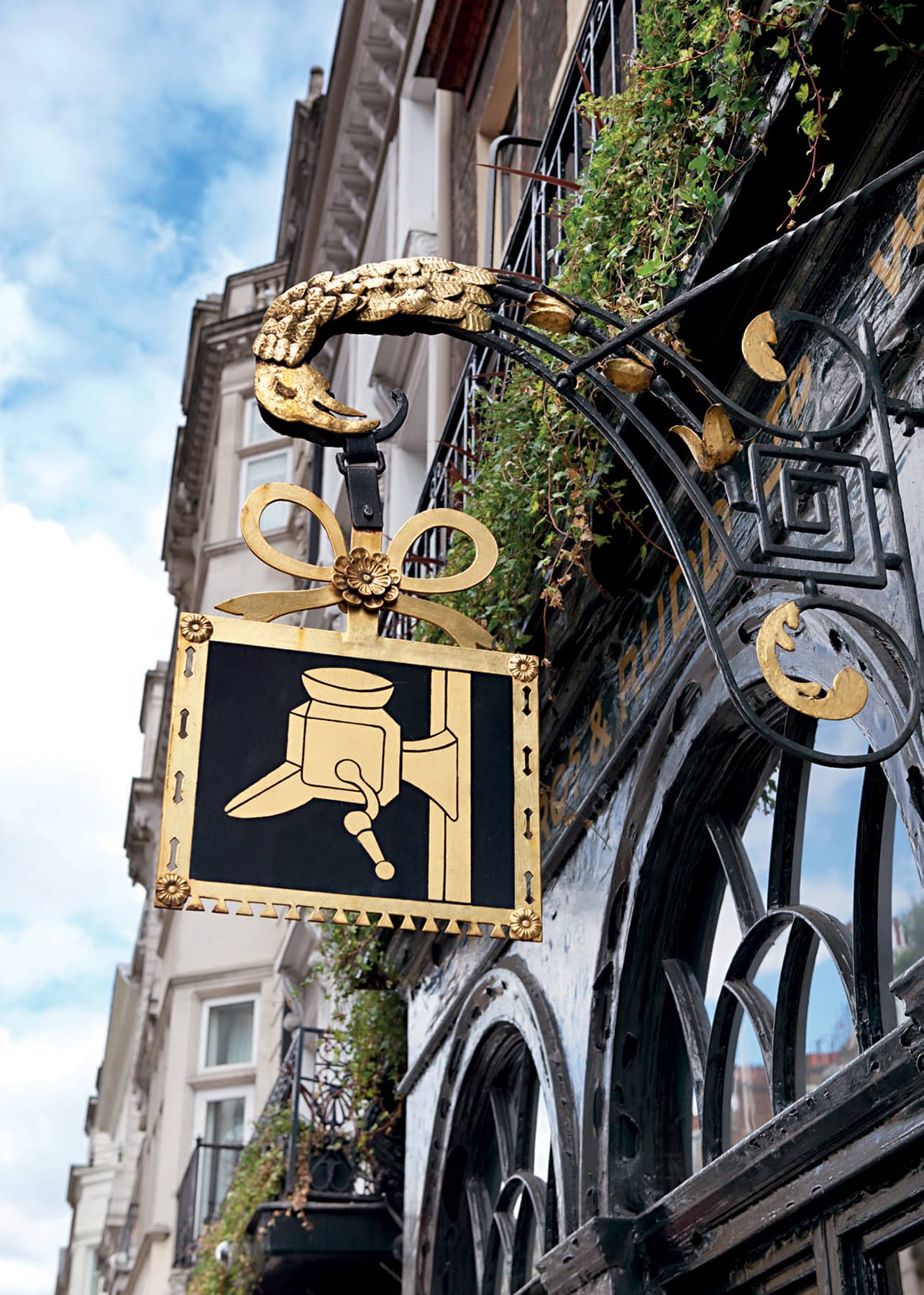
Berry Bros & Rudd retains its original signage from the time when it was a coffee dealer.

Bessie the barrel lift: the winch for lifting goods from street level is still in occasional use.
Berry Bros & Rudd are Britain’s oldest wine and spirit merchants, still operating under the ownership and management the Berry and Rudd families, now an international company with offices in Hong Kong, Singapore and Japan, and buying and selling wines from around the world. As well as having long history, they claim to be the first wine merchants to open an online wine shop in 1994, and to establish an online wine broking exchange. The main warehouse in Basingstoke opened as recently as 1967, while No. 3 St James’s Street continues as the flagship store and continues to expand its cellars.
One of these is Pickering Cellar, which extends under Pickering Place behind, dating from at least the seventeenth century. At the entrance is an alcove where Louis Napoleon, nephew to Napoleon Bonaparte, once took refuge in a dangerous moment during the Chartist riots of the 1840s. He lived nearby on King Street, exiled following his second failed coup to become President of France. He and George Berry were friends and, together with the chef of The Athenaeum, had joined the militia to suppress the riots. When Louis Napoleon departed in 1848 he left his truncheon behind. It still hangs outside the cellar.
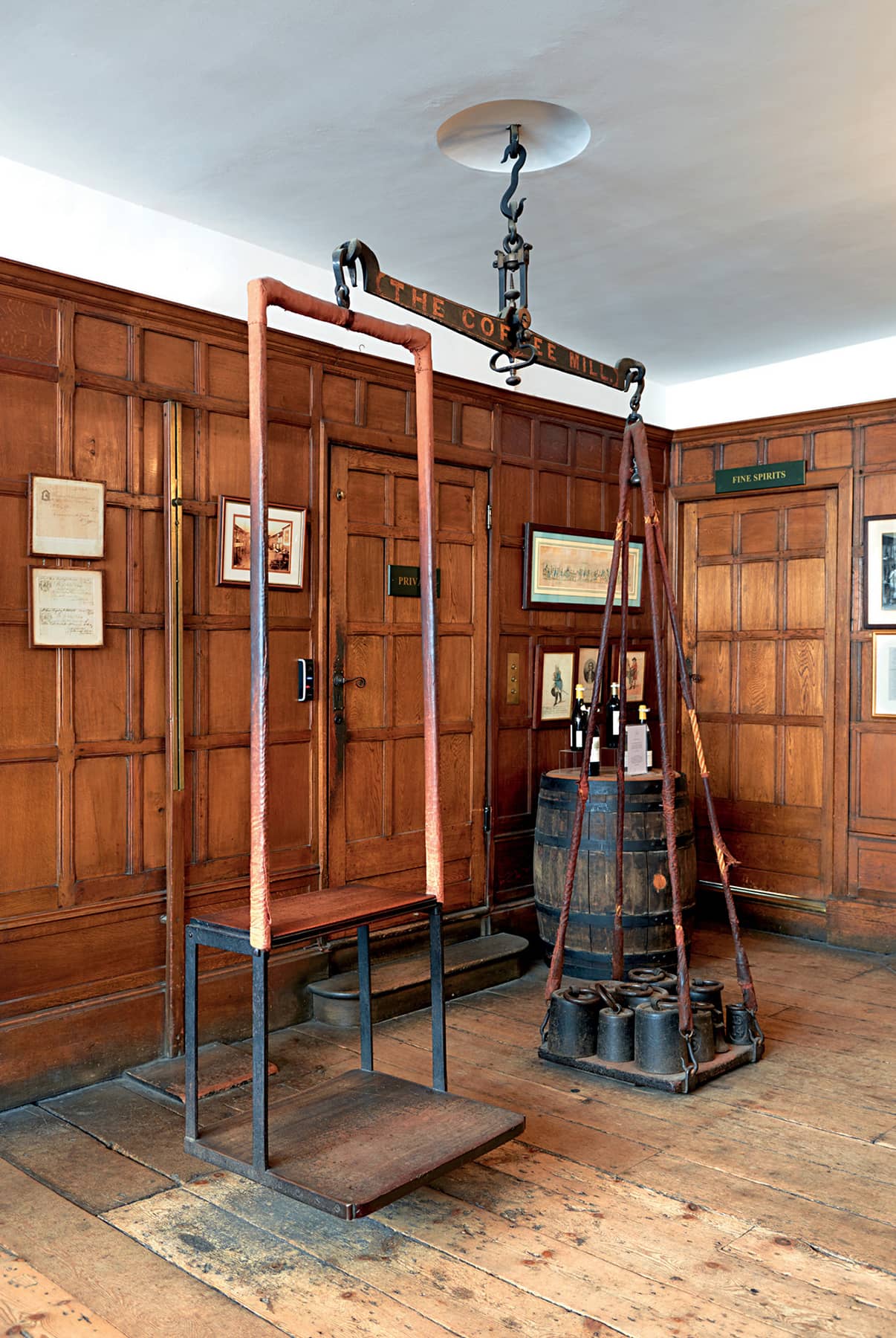
An original set of scales for coffee, and occasionally people.

Pickering Place, the smallest public square in London.
The space was once employed as a bottling cellar. Barrels were lowered on a hoist that is still sometimes used to take wine down from street level. The cellar is home to Berry Bros & Rudd’s wine school.
Another cellar is accessed through a discrete door in one of the houses in the courtyard behind. This is Sussex Cellar, built on two levels, in which thirty-six can dine. It is named after the Duke of Sussex, one of seven royal dukes who were customers of the company in the early nineteenth century. The cellar is a modernised space, influenced by Spanish bodegas, using tiles to create archways and columns through the mezzanine and the sub-basement level.
A walk through the alley to the side of Berry Bros & Rudd leads to Pickering Place, claimed to be the oldest and the smallest public courtyard in London. This gas-lit enclave, with a sundial in the form of an astrolabe at the centre, is surrounded by five houses; over time it was home to a gambling den, bear-baiting, cockfighting, dog fighting and a number of duels, one of which was fought by Beau Brummell. It was once the site of Henry VIII’s royal tennis court, with remnants of one wall remaining below ground. Prime Minister Lord Palmerston lived in the square, and later the novelist Graham Greene. No. 3 Pickering Place is the Berry Bros & Rudd Townhouse, home to receptions in its Green Room and Long Room.
The most curious feature of the wainscoted alley leading to Pickering Place is described by a plaque just inside the entrance. A doorway here once led upstairs to the rooms used by the Texas Legation between 1836 and 1845. Effectively the Embassy of the Republic of Texas in Britain, it was established to support the international cause of the country, which was then a sovereign republic independent from the United States and Mexico. General Sam Houston, the Texan President, dispatched a diplomatic representative to London who worked in rooms leased from the wine merchants.
VISITING INFORMATION
Berry Bros & Rudd, 3 St James’s Street, SW1A 1EG
Open 10am–9pm Monday–Friday; 10am–5pm Saturday.